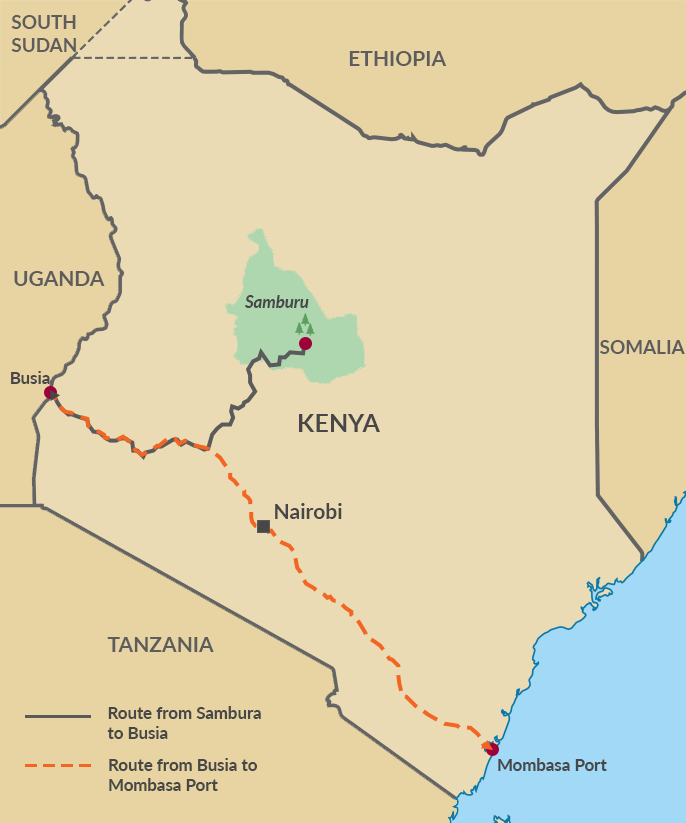East Africa’s endangered sandalwood tree is being illegally harvested at a rate that could see it becoming extinct. It’s also resulting in the loss of biodiversity and the loss of a critical medicinal resource for local communities. Increased over-exploitation of this wood was noted in Kenya in 2006. People uproot the whole tree to extract the sandalwood oil, which is mostly found in the roots and trunk. The Kenya Forest Service, the government conservation body, was alarmed by the methods of harvesting. This led swiftly to the 2007 ban on its harvesting.
Over the past two decades, and despite the ban, sandalwood has been increasingly harvested to extract its essential oils, which meet the demand of the pharmaceutical industry in the production of medicines and cosmetics. A burgeoning illegal trade has grown with this demand. Here trafficking networks in East Africa exploit community forests in northern Kenya to illegally profit from harvesting the endangered tree.
However, sandalwood trafficking has continued in the region due to the high demand from Asia for its oil. In many Asian communities, the oil is popular in socio-cultural and religious ceremonies as well as in traditional medicine. On the international market, one litre of sandalwood oil sells for as much as $3 000.
In 2018 the East African sandalwood tree was listed on the Convention on International Trade in Endangered Species of Wild Fauna and Flora (CITES). It is also listed in the International Union for Conservation of Nature’s Red List of Threatened Species.
According to John Partangu, a community leader in Samburu County, ‘Illicit traders often come to Maralal town and hire local youth who direct them to “technicians” – people with local knowledge in identifying the male and female sandalwood trees. The female tree is prized due to the belief that it yields more oil, although this is unsubstantiated.
‘These technicians then supervise the harvesting of sandalwood from the forests and its transportation on donkeys to local homesteads (by members of the community) where fees for security and storage are paid to locals.’
Community members with unfettered access to forests in Lodung’okwe, South Horr, and Wamba in Samburu County work closely with ‘technicians’ to identify and harvest trees with high oil potential.
Local youth are paid KSh30/kg for wood and roots harvested from these trees. The sandalwood ‘owners’ – those with rights to access public forests based on their location on community land – are paid KSh300/kg of harvest. The wood is transported from the forests on donkeys and stored in local homesteads, where middlemen provide onward transport for the product to nearby town centres.
The wood is then transported using different routes. The Wamba-Sura Adoru-Suguta land route mainly serves to traffic sandalwood out of Samburu County, while the Wamba-Sura Adoru-Suguta-Rumuruti-Nyahururu-Nakuru route enables traffickers to move their illegal goods towards the Kenyan-Uganda border.
The town centres serve as venues for repackaging the wood for onward transport using police vehicles, ambulances, or high-end vehicles through panya routes or designated borders such as the Busia and Malaba crossing with Uganda. Panya routes are illegal entry points used for smuggling goods and people.
The sandalwood is taken across the border to Tororo in Uganda, where it is semi-processed and exported through the Kenyan Port of Mombasa to markets in Asia and the Arabian Gulf, such as India, China, Saudi Arabia, and Dubai. This means that Kenyan security and customs officials have twice the opportunity to apprehend traffickers in their territory. The wood is also trafficked to neighbouring Tanzania.
According to a senior conservation official in Kenya, ‘Sandalwood trafficking in the country is mostly facilitated by political leaders who use their leverage to exploit community resources for personal gain.’
Criminal charges for trading in endangered or threatened species (section 92 of Wildlife Conservation Management Act 2013) were preferred against Kenya Wildlife Service officers involved in sandalwood trafficking, showing that the very custodians of Kenya’s flora are part of these syndicates. This highlights the governance and ethical challenges in the implementation of environmental laws and calls for better oversight to ensure that state officers protect public goods and resources.
The lack of uniformity in regional regulations, therefore, plays a critical role in aiding trafficking in the region. The sandalwood trade may be banned in Kenya, yet just over the border a licensed factory that semi-processes the wood in Tororo is a convenient way to make the illegally harvested wood ‘disappear’.
It is critical that environmental regulations in Tanzania and Uganda align to the CITES designation of the East African sandalwood as a threatened species.
Tackling this over-exploitation requires a range of responses. In addition to addressing the criminal justice response, there needs to be a concerted effort at the community level in Kenya to preserve this valuable tree. Community-based conservation approaches to gain local support and ensure the protection of the tree and preserving its socio-cultural value.
Willis Okumu, Senior Researcher – East and Horn of Africa, ENACT project, ISS








